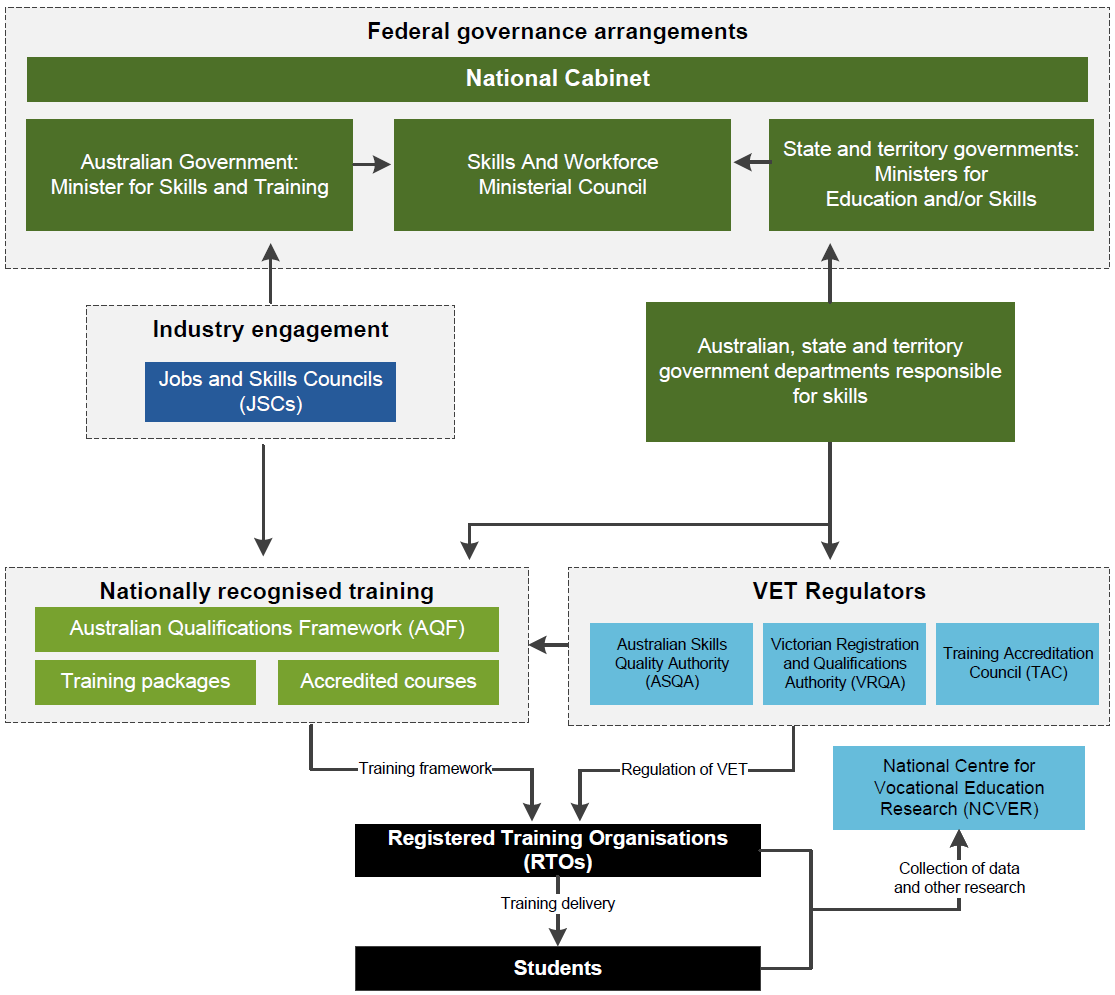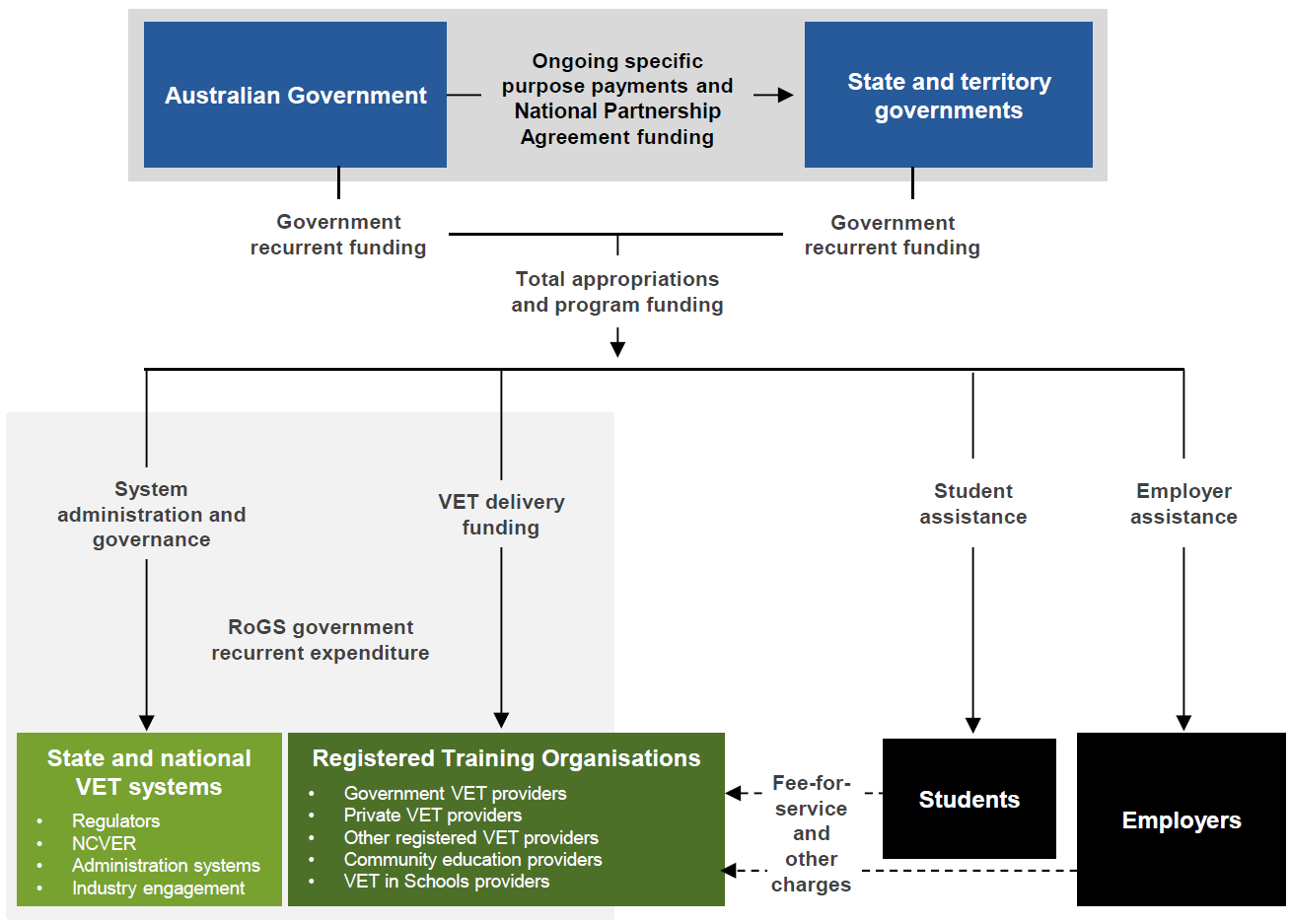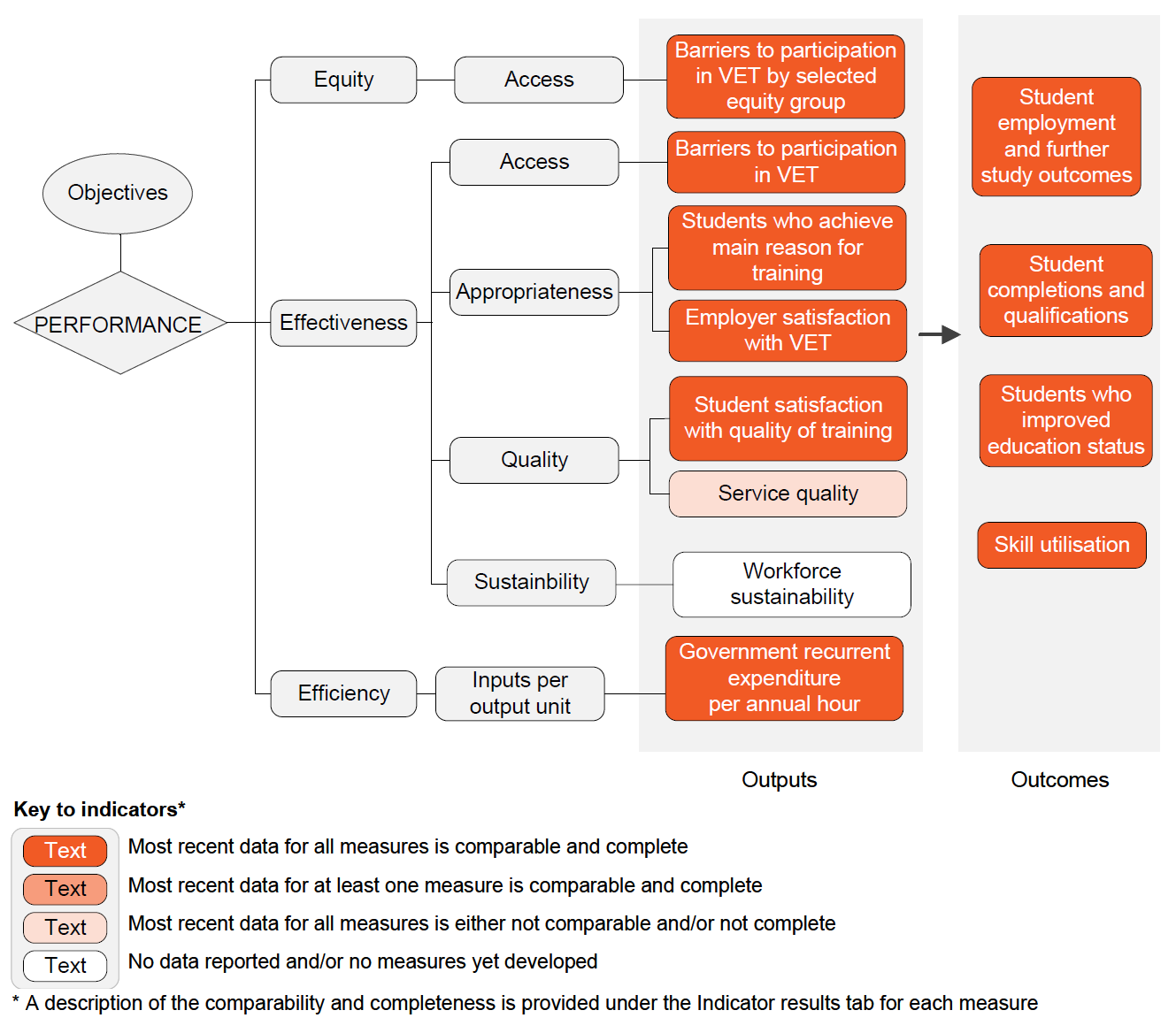WORKING GROUP DRAFT – IN CONFIDENCEReport on Government Services 2026
PART B, SECTION 5: RELEASED ON 10 FEBRUARY 2026
5 Vocational education and training
This section reports performance information for vocational education and training (VET) services.
The Indicator results tab uses data from the data tables to provide information on the performance for each indicator in the Indicator framework. The same data is also available in CSV format.
Data downloads
![]() 5 Vocational education and training data tables (XLSX 312.9 KB)
5 Vocational education and training data tables (XLSX 312.9 KB)
![]() 5 Vocational education and training dataset (CSV 898.7 KB)
5 Vocational education and training dataset (CSV 898.7 KB)
Refer to the corresponding table number in the data tables for detailed definitions, caveats, footnotes and data source(s).
Objectives for vocational education and training (VET)
The VET system aims to deliver a productive and highly skilled workforce through enabling all working age Australians to develop and use the skills required to effectively participate in the labour market and contribute to Australia's economic future. To achieve this, the Australian, state and territory governments aim to create a national training system that:
- is accessible to all working age Australians
- meets the needs of students, employers and industries
- is high quality and sustainable.
Governments aim for a national training system that meets these objectives in an equitable and efficient manner.
The VET system provides training for entry level jobs through to highly technical occupations, and also provides training for non-employment related reasons. Nationally in 2024, the main reason qualification completers participated in VET was for:
- employment related reasons (72.8% in total VET and 73.5% in government-funded VET)1
- personal development (14.7% in total VET and 13.8% in government-funded VET)
- pathways to further study (12.4% in total VET and 12.6% in government-funded VET) (NCVER 2024a).
[DN: These dot points will be updated in the mid-year update]
To achieve these aims, a student may choose to complete a single subject/unit of competency, module, skill set or VET qualification. VET qualifications range from Certificate I to Graduate Diploma, as determined by the Australian Qualifications Framework (AQF).
In this section, the 2026 RoGS reports performance indicators for VET activity among people aged 15–64 years, representing the working age population. This approach differs from previous editions of the RoGS.
- Total VET refers to nationally recognised vocational education and training activity delivered by Australian registered training organisations (RTOs) to students who undertook nationally recognised VET on a government-funded or fee-for-service basis. All data for non-nationally recognised training and delivery from non-registered training providers has been excluded from reporting of total VET activity in this report. Locate Footnote 1 above
VET is an area of shared responsibility between interlinked government, industry and individual stakeholders (figure 5.1).
Figure 5.1 VET roles and responsibilities

Federal governance arrangements
For the 2023-24 reporting period, government roles and responsibilities were outlined in the National Skills Agreement, as summarised below:
- The Australian Government provides financial support to state and territory governments to sustain national training systems and provides specific incentives, interventions and assistance to support access and delivery of national priorities.
- State and territory governments manage VET delivery systems within their jurisdiction (including the effective operation of the training market).
- The Australian Government and state and territory governments work together to progress and implement national priorities. The Skills and Workforce Ministerial Council, established in late 2022, provides a forum for national cooperation and stewardship across the VET system, with a reporting line to the National Cabinet. The scope of the Council includes strategic policy planning, performance evaluation, cross-sectoral alignment and the interaction between VET and broader workforce issues.
As of 2026, there are two active agreements between the Australian Government and state and territory governments relating to skills and workforce development:
- Fee-Free Technical and Further Education (TAFE) Skills Agreement delivers fee-free training places at TAFE institutes in agreed national priority industry areas, and with a focus on priority equity groups across Australia over 2023 to 2026
- five-year National Skills Agreement, that commenced on 1 January 2024, delivers on the nationally shared vision and principles to strengthen the VET sector, with focused effort to address critical skills and workforce shortages.
Industry engagement arrangements
JSCs are not-for-profit companies that are owned and led by industry. They provide strategic leadership to identify and address skills and workforce challenges for their industry. The national network of 10 JSCs encompass most industry sectors, and brings together employers, unions and governments in a tripartite arrangement. Employer organisations and unions work together on JSCs governance (board composition, membership structures) and operational arrangements (strategic taskforces, sub-committees and technical committees).
JSCs have four core functions:
- Workforce planning – creating a consistent, strategic approach to addressing skill gaps in their industry sector
- Training product development – developing training products in line with standards set by Skills Ministers to improve quality, responsiveness and speed to market
- Implementation, promotion and monitoring – partnering with RTOs to align workforce planning and training products with career advice and training delivery
- Industry stewardship – providing intelligence on workforce issues affecting industry and advice on national VET system policies.
The Department of Employment and Workplace Relations undertakes quality assurance assessments of training packages developed by JSCs to ensure they meet the national standards and policies set by Skills Ministers.
Regulation of VET
ASQA is the national regulator for the VET sector. ASQA accredits courses and regulates RTOs to ensure the nationally approved Standards for RTOs 2015 (the Standards) are met. ASQA has jurisdiction over all RTOs, except for those that are regulated by the Victorian and Western Australian state regulators.
VRQA and TAC use the Standards as a baseline for regulating RTOs, but also measure provider compliance against other regulatory frameworks, for example the VRQA Guidelines for VET or Western Australia's Vocational Education and Training Act 1996.
Nationally, as at 30 June 2025:
- ASQA regulated 3,751 (93.1%) RTOs in Australia
- VRQA regulated 118 (2.9%) RTOs delivering training to domestic students in Victoria only or in Victoria and Western Australia
- TAC regulated 162 (4.0%) RTOs delivering training to domestic students in Western Australia and Victoria (ASQA 2025).
Registered Training Organisations
RTOs are those training providers registered by ASQA, VRQA or TAC to deliver VET services, including:
- government VET providers – including TAFE institutes, agricultural colleges and multi-sector education institutions
- community education providers – including adult and community education providers
- other registered providers – including private training businesses, industry and community bodies with an RTO arm, employers that have RTO status to train their own staff, Group Training Organisations (GTOs) or Apprenticeship Network Providers that also deliver VET services.
Nationally recognised training (NRT)
NRT leads to vocational qualifications and credentials that are recognised across Australia. It consists of the following components:
- Training packages specify the knowledge and skills (known as competencies) required by individuals to perform effectively in the workplace. Training packages detail how units of competency can be packaged into nationally recognised qualifications that align to the AQF.
- Accredited qualifications refer to nationally recognised courses that lead to a qualification outcome not specified in a national training package.
- Accredited courses have been assessed by a VET regulator as compliant with the Standards for VET Accredited Courses 2021.
- Training package skill sets are defined as single units of competency, or combinations of units of competency from an endorsed training package, which link to a licensing or regulatory requirement, or a defined industry need.
- Units of competency and accredited modules define the skills and knowledge to operate effectively in a workplace context. They are the smallest units or modules that can be assessed and recognised.
All NRT is listed on the National Register of VET (training.gov.au) and only RTOs can deliver NRT and issue nationally recognised qualifications or statements of attainment on the full or partial completion of training (NCVER 2024b). Apprenticeships or traineeships combine employment and competency-based training, including both formal NRT and on-the-job training.
Figure 5.2 outlines the major funding flows within the VET system.
Figure 5.2 Major funding flows within the VET system

Government recurrent expenditure
In this report, government recurrent expenditure refers to Australian Government and state and territory government expenditure that is directly related to the provision of VET services and delivered to the community by, or on behalf of, the government. This includes:
- VET delivery funding – funding provided to RTOs that directly delivers a training outcome. This includes funding for subsidised training and further subsidies targeted at supporting access and recognising additional delivery costs.
- System administration and governance – funding of costs associated with supporting the state/territory and national VET system.
Nationally in 2023, total government real recurrent expenditure, including user cost of capital was $8.1 billion – an increase from $7.7 billion in 2022 (figure 5.3).
Total government real recurrent expenditure per person aged 15–64 years, excluding user cost of capital, was $405 in 2023 (table 5A.2).
Total government funding of VET
Within the VET system, there are several other funding flows that are outside the scope of government recurrent expenditure (see figure 5.2).
The Australian Government provides funding to state and territory governments through payments under Federation Funding Agreements. Nationally in 2023, the Australian Government provided around $2.1 billion to state and territory governments, the majority was provided through ongoing specific purpose payments ($1.6 billion) and the remainder from National Partnership Agreement funding ($476.1 million) (table 5A.3). These funds indirectly contribute to state and territory government real recurrent expenditure on VET services.
Government recurrent funding captures the funds provided by each jurisdiction to cover their training portfolio costs and relevant VET programs. Along with VET delivery funding and system administration and governance, this includes:
- Employer assistance – funding that incentivises and supports employers to engage in VET, including subsidies, incentives, grants and other payments, and tax exemptions
- Student assistance – funding that supports students with non-tuition costs associated with undertaking VET, including loans and grants or subsidies.
Nationally in 2023, government recurrent funding totaled $8.3 billion – a decrease from $8.8 billion in 2022 (table 5A.3). Total government appropriations and real recurrent program funding for VET, inclusive of Australian Government transfers to the states and territories, totaled $10.4 billion in 2023 – down from $11.2 billion in 2022.
Allocation of funding
Nationally in 2024, $X.X billion of VET funding was allocated through a competitive basis (table 5A.4). The mechanisms for contestable allocation of funds include open competitive tendering, limited competitive tendering and eligible grants, user choice and entitlement funding (refer to ‘Explanatory material’ tab for definitions).
Government VET delivery funding is provided to a mixture of government RTOs (including TAFEs), private RTOs, other RTOs and community education providers. Nationally in 2023, government VET delivery funding paid to non-TAFE providers totaled nearly $1.5 billion – around 24% of total VET delivery funding and a 3.6% real increase from 2022 (table 5A.5).
Students
Nationally in 2023, over 5 million students were enrolled in VET (total VET students) (figure 5.4). Around 2.1 million students were enrolled in qualifications, of which the majority were studying Certificate III or IV qualifications (over 1.4 million), followed by Certificate I or II (436,300), and Diploma or above (393,000). Almost 3.5 million students were enrolled in subjects not delivered as part of a nationally recognised program.
Nationally in 2023, over 1.2 million students were enrolled in government-funded VET (figure 5.4). The majority (almost 1.1 million) of students were studying government-funded qualifications, with Certificate III or IV being the most common (XX). A smaller number of government-funded students were enrolled in locally developed programs, training package skills sets or accredited courses and standalone nationally recognised subjects.
Number of total and government-funded VET students aged 15–64 years in selected equity groups is available in tables 5A.8–9.
Data on participation in total and government-funded VET by people aged 15–64 years in selected equity groups is available in tables 5A.10–11. Population data for all people and selected equity groups aged 15–64 years used to calculate rates is available in table 5A.12.
Training providers
Nationally in 2023, there were 3,607 registered VET training organisations delivering nationally recognised training in Australia (table 5A.13), of which 1,285 delivered nationally recognised government-funded VET through state and territory training departments (NCVER, unpublished). There were 1,481 VET providers delivering government-funded training, which includes both nationally and non-nationally recognised as well as locally developed programs, at 34,879 locations in Australia (table 5A.14).












